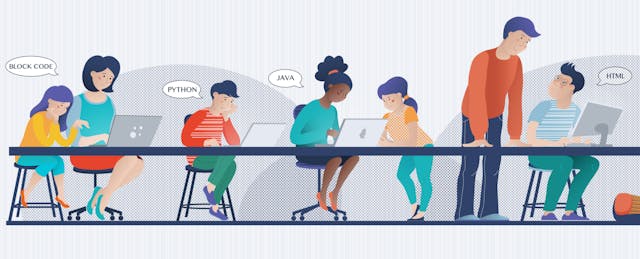In the 10 months since Girls Who Code announced a set of policy recommendations aimed at closing the gender gap in K-12 computer science, the national nonprofit has been working with states to promote legislation that would help measure the extent of the gender disparity in U.S. classrooms.
On Wednesday, Washington became the first state to get on board with Girls Who Code’s policy agenda when Gov. Jay Inslee, a Democrat, signed into law a bill written with the expressed intention of closing the gender gap in computer science fields.
“This is landmark legislation,” Corinne Roller, director of advocacy and public policy at Girls Who Code, tells EdSurge. “It’s going to put Washington ahead of a lot of other states, in terms of closing the gender gap and all the other gaps that we know exist in computer science.”
The bill—which is “almost word-for-word” the language Girls Who Code recommended, Roller says—requires that K-12 schools in Washington track and publicly report the number of computer science classes they offer and who enrolls in them. Specifically, schools must disclose the number and percentage of students who participate in computer science courses, with demographic breakdowns by gender, race and ethnicity, English learner status, eligibility for free-and-reduced lunch, special education status and grade level.
According to the bill, schools are required to submit this data annually to the state’s education department, the Office of the Superintendent of Public Instruction. They will begin tracking and recording the information in the 2019-2020 school year, with their first submission due in June 2020. The education department will then compile all the school data into a report published “conspicuously” on its website, according to the bill.
By most measures, Washington is at the front of the pack when it comes to computer science education. The state adopted K-12 computer science standards in 2016, has dedicated funding for teacher training in the field, and allows computer science to count toward a core graduation requirement. But these are only measures of access, not participation, and “access alone is not enough,” Roller says. “We know that. We see that.”
Girls account for less than 25 percent of students participating in K-12 computer science classes in Washington State—a metric that decreased in the most recent school year, according to state records obtained by Girls Who Code. Under the new legislation, school data on this issue will become more comprehensive and transparent, allowing education leaders to better assess the severity of the gender gap and how much work remains before they can achieve gender parity in K-12 classrooms.
“We are starting with data tracking and participation because we don’t know the extent of the problem we’re dealing with, and you can’t solve a problem if you don’t understand it,” Roller explains. “We know our goal—parity—but if we don’t know where we’re starting from, it’s hard to get there.”
Although the new reporting may present additional work for schools, the data Washington is requesting should not pose a heavy additional burden for school staff, Roller assures. “It’s well within the realm of what they’re already asked to report,” she says.
In Washington, the state already collects this data from its high schools but does not disclose it publicly. The legislation signed Wednesday will require it be made public and will extend that requirement to K-8 schools.
“We hope, once this information is out there, it will spur a lot of changes, and we can work to implement the other pieces of our agenda,” Roller says.
Later this year, she adds, other states are expected to pass legislation like Washington’s. Girls Who Code is currently in talks with officials in Colorado and Maryland, among a handful of other states, about their own versions of the bill.


